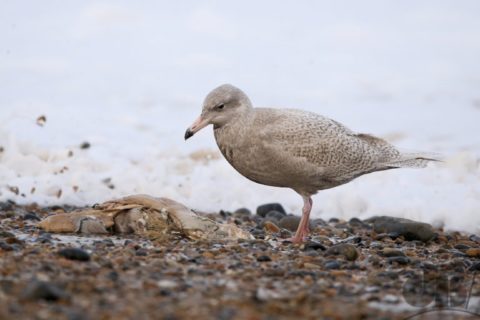The Glaucous Gull (Larus hyperboreus) is the world’s second largest gull (largest is the Great Black-backed Gull (Larus marinus). It breeds in The Arctic but we do see them further south. My photograph is of a first winter youngster, juvenile gull. It is feeding on seal blubber on the beach way East of the beach carpark at Cley-next-the-Sea in North Norfolk (we saw a few dead seals on the beach on this visit perhaps battered in yesterday’s high winds and rough seas).

The word “glaucous” is descriptive of the adult bird’s colour. It simply means “dull bluish-green, gray,” but somehow that came from the Latin word glaucus meaning “bright, sparkling, gleaming,” but there’s also bluish-green,” from Greek glaukos. Homer used the term when describing the sea to simply mean “gleaming and silvery” with no suggestion of colour. It was later used to refer to “blue, gray” eyes. Indeed, the eye condition glaucoma is perhaps somehow connected with cataracts which lead the pupils of the eyes to take on this cast as the lenses become more and more opaque.
The first part of its scientific name, the Larus of Larus hyperboreus refers to the genus and its etymology is Latin for gull, or perhaps just a large seabird. The second part of the name, hyperboreus, means far north (boreus as in Aurora borealis, see also Ancient Greek for people from the far North, the Huperboreoi).
As Mrs Sciencebased pointed out, this immature Glaucous Gull does look rather like a juvenile Herring Gull (Larus argentatus), but there are distinguishing features: size, beak, and colouration.